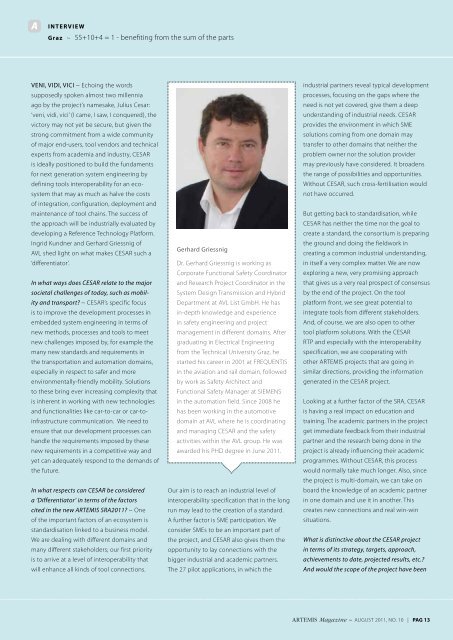interview - Cesar
interview - Cesar
interview - Cesar
Create successful ePaper yourself
Turn your PDF publications into a flip-book with our unique Google optimized e-Paper software.
INTERVIEW<br />
Graz ~ 55+10+4 = 1 - benefiting from the sum of the parts<br />
Veni, Vidi, Vici ~ Echoing the words<br />
supposedly spoken almost two millennia<br />
ago by the project’s namesake, Julius <strong>Cesar</strong>:<br />
‘veni, vidi, vici’ (I came, I saw, I conquered), the<br />
victory may not yet be secure, but given the<br />
strong commitment from a wide community<br />
of major end-users, tool vendors and technical<br />
experts from academia and industry, CESAR<br />
is ideally positioned to build the fundaments<br />
for next generation system engineering by<br />
defining tools interoperability for an ecosystem<br />
that may as much as halve the costs<br />
of integration, configuration, deployment and<br />
maintenance of tool chains. The success of<br />
the approach will be industrially evaluated by<br />
developing a Reference Technology Platform.<br />
Ingrid Kundner and Gerhard Griessnig of<br />
AVL shed light on what makes CESAR such a<br />
‘differentiator’.<br />
In what ways does CESAR relate to the major<br />
societal challenges of today, such as mobility<br />
and transport? ~ CESAR’s specific focus<br />
is to improve the development processes in<br />
embedded system engineering in terms of<br />
new methods, processes and tools to meet<br />
new challenges imposed by, for example the<br />
many new standards and requirements in<br />
the transportation and automation domains,<br />
especially in respect to safer and more<br />
environmentally-friendly mobility. Solutions<br />
to these bring ever increasing complexity that<br />
is inherent in working with new technologies<br />
and functionalities like car-to-car or car-toinfrastructure<br />
communication. We need to<br />
ensure that our development processes can<br />
handle the requirements imposed by these<br />
new requirements in a competitive way and<br />
yet can adequately respond to the demands of<br />
the future.<br />
In what respects can CESAR be considered<br />
a ‘Differentiator’ in terms of the factors<br />
cited in the new ARTEMIS SRA2011? ~ one<br />
of the important factors of an ecosystem is<br />
standardisation linked to a business model.<br />
We are dealing with different domains and<br />
many different stakeholders; our first priority<br />
is to arrive at a level of interoperability that<br />
will enhance all kinds of tool connections.<br />
Gerhard Griessnig<br />
Dr. Gerhard Griessnig is working as<br />
Corporate Functional Safety Coordinator<br />
and Research Project Coordinator in the<br />
System Design Transmission and Hybrid<br />
Department at AVL List GmbH. He has<br />
in-depth knowledge and experience<br />
in safety engineering and project<br />
management in different domains. After<br />
graduating in Electrical Engineering<br />
from the Technical University Graz, he<br />
started his career in 2001 at FREQUENTIS<br />
in the aviation and rail domain, followed<br />
by work as Safety Architect and<br />
Functional Safety Manager at SIEMENS<br />
in the automation field. Since 2008 he<br />
has been working in the automotive<br />
domain at AVL where he is coordinating<br />
and managing CESAR and the safety<br />
activities within the AVL group. He was<br />
awarded his PHD degree in June 2011.<br />
our aim is to reach an industrial level of<br />
interoperability specification that in the long<br />
run may lead to the creation of a standard.<br />
A further factor is SME participation. We<br />
consider SMEs to be an important part of<br />
the project, and CESAR also gives them the<br />
opportunity to lay connections with the<br />
bigger industrial and academic partners.<br />
The 27 pilot applications, in which the<br />
industrial partners reveal typical development<br />
processes, focusing on the gaps where the<br />
need is not yet covered, give them a deep<br />
understanding of industrial needs. CESAR<br />
provides the environment in which SME<br />
solutions coming from one domain may<br />
transfer to other domains that neither the<br />
problem owner nor the solution provider<br />
may previously have considered. It broadens<br />
the range of possibilities and opportunities.<br />
Without CESAR, such cross-fertilisation would<br />
not have occurred.<br />
But getting back to standardisation, while<br />
CESAR has neither the time nor the goal to<br />
create a standard, the consortium is preparing<br />
the ground and doing the fieldwork in<br />
creating a common industrial understanding,<br />
in itself a very complex matter. We are now<br />
exploring a new, very promising approach<br />
that gives us a very real prospect of consensus<br />
by the end of the project. on the tool<br />
platform front, we see great potential to<br />
integrate tools from different stakeholders.<br />
And, of course, we are also open to other<br />
tool platform solutions. With the CESAR<br />
RTP and especially with the interoperability<br />
specification, we are cooperating with<br />
other ARTEMIS projects that are going in<br />
similar directions, providing the information<br />
generated in the CESAR project.<br />
Looking at a further factor of the SRA, CESAR<br />
is having a real impact on education and<br />
training. The academic partners in the project<br />
get immediate feedback from their industrial<br />
partner and the research being done in the<br />
project is already influencing their academic<br />
programmes. Without CESAR, this process<br />
would normally take much longer. Also, since<br />
the project is multi-domain, we can take on<br />
board the knowledge of an academic partner<br />
in one domain and use it in another. This<br />
creates new connections and real win-win<br />
situations.<br />
What is distinctive about the CESAR project<br />
in terms of its strategy, targets, approach,<br />
achievements to date, projected results, etc.?<br />
And would the scope of the project have been<br />
ARTEMIS Magazine ~ AUGUST 2011, No. 10 | PAG 13



